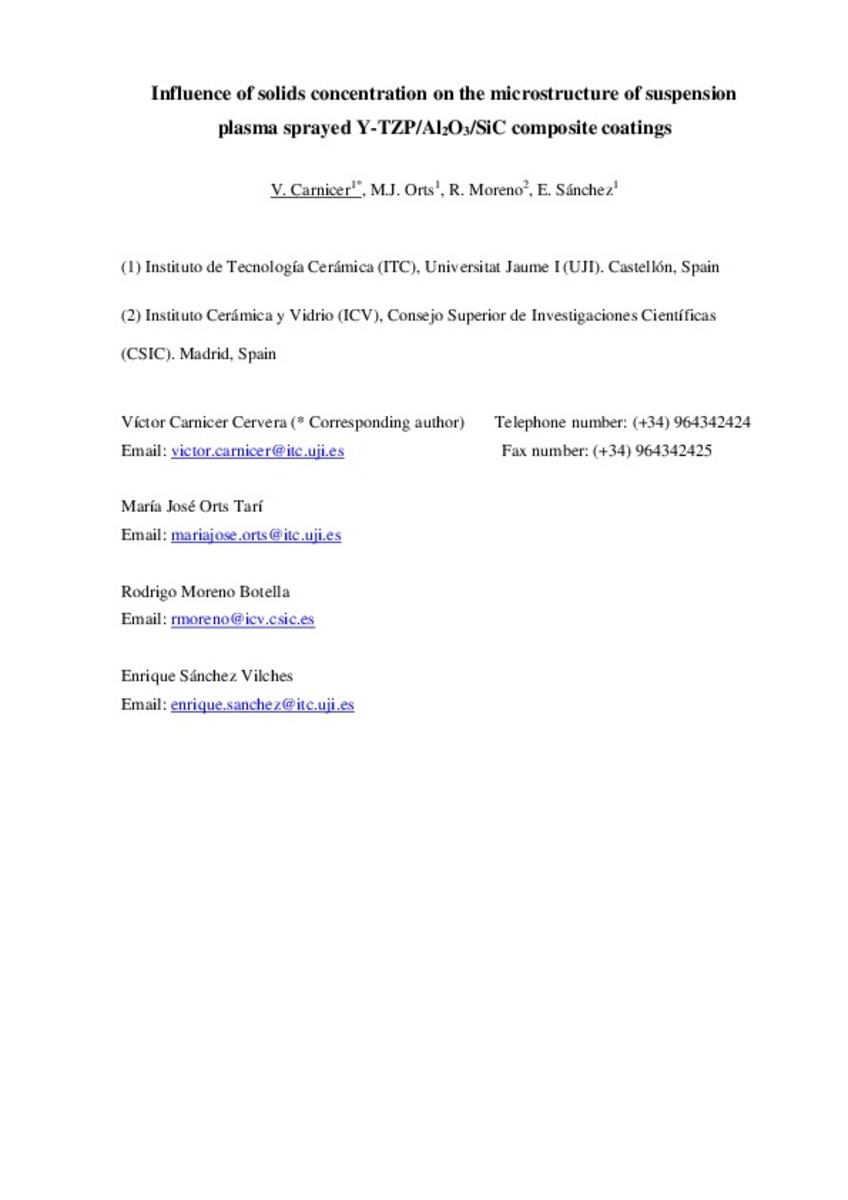Mostrar el registro sencillo del ítem
Influence of solids concentration on the microstructure of suspension plasma sprayed Y-TZP/Al2O3/SiC composite coatings
| dc.contributor.author | Carnicer Cervera, Víctor | |
| dc.contributor.author | Orts Tarí, María José | |
| dc.contributor.author | Moreno, Rodrigo | |
| dc.contributor.author | Sánchez-Vilches, Enrique | |
| dc.date.accessioned | 2019-03-11T16:27:10Z | |
| dc.date.available | 2019-03-11T16:27:10Z | |
| dc.date.issued | 2019 | |
| dc.identifier.citation | Carnicer, V., et al. "Influence of solids concentration on the microstructure of suspension plasma sprayed Y-TZP/Al2O3/SiC composite coatings." Surface and Coatings Technology, 2019 | ca_CA |
| dc.identifier.issn | 0257-8972 | |
| dc.identifier.issn | 1879-3347 | |
| dc.identifier.uri | http://hdl.handle.net/10234/181814 | |
| dc.description.abstract | The present research focuses on the effect of feedstock suspension solid concentration on the microstructure of suspension plasma sprayed Y-TZP/Al2O3/SiC composite coatings. For this purpose, concentrated aqueous suspensions were prepared at 10, 20 and 30 vol.% of particles. Suspensions were characterised in terms of colloidal stability, rheological behaviour and sedimentation trend. The optimised suspensions were plasma sprayed, and the thickness, porosity, amount of resolidified particles and SiC content in the coatings were evaluated by optical microscopy, scanning electron microscopy and X-ray diffraction. The results revealed that stand-off distance and suspension solid content have a strong and similar influence on the coating microstructure due to the great impact that these two parameters exerts on the energy that particles and substrate receive during plasma operation. Thus, cauliflower-like microstructure is well-developed in most of the coatings, particularly for longer distances and lower solid contents. Porosity and amount of resolidified particles in the coatings are favoured by increasing the stand-off distance and decreasing the solids content, while thickness is strongly affected by solids content variation. On the other hand, Rietveld method from X-ray diffraction showed that large amount of the initial SiC was preserved in the final coatings whereas this amount remains almost constant for the three suspension feedstock tested. | ca_CA |
| dc.format.extent | 26 p. | ca_CA |
| dc.format.mimetype | application/pdf | ca_CA |
| dc.language.iso | eng | ca_CA |
| dc.publisher | Elsevier | ca_CA |
| dc.relation.isPartOf | Surface and Coatings Technology, 2019 | ca_CA |
| dc.rights.uri | http://rightsstatements.org/vocab/CNE/1.0/ | * |
| dc.subject | thermal barrier coatings | ca_CA |
| dc.subject | suspension plasma spraying | ca_CA |
| dc.subject | high solid content | ca_CA |
| dc.subject | multicomponent | ca_CA |
| dc.subject | self-healing | ca_CA |
| dc.title | Influence of solids concentration on the microstructure of suspension plasma sprayed Y-TZP/Al2O3/SiC composite coatings | ca_CA |
| dc.type | info:eu-repo/semantics/article | ca_CA |
| dc.identifier.doi | https://doi.org/10.1016/j.surfcoat.2019.01.078 | |
| dc.relation.projectID | The authors of this work are grateful to support of Spanish Ministry of Economy, Industry and Competitiveness and FEDER Funds under the Grant no MAT2015-67586-C3-R, and the Research Promotion Plan of the Universitat Jaume I for the predoctoral fellowship (re. PREDOC/2017/51) | ca_CA |
| dc.rights.accessRights | info:eu-repo/semantics/openAccess | ca_CA |
| dc.relation.publisherVersion | https://www.sciencedirect.com/science/article/pii/S0257897219300957 | ca_CA |
| dc.type.version | info:eu-repo/semantics/submittedVersion | ca_CA |
Ficheros en el ítem
Este ítem aparece en la(s) siguiente(s) colección(ones)
-
ITC_Articles [74]
-
QUI_Articles [296]







